Croatia’s culinary treasures celebrated on new commemorative stamps
- by croatiaweek
- in News
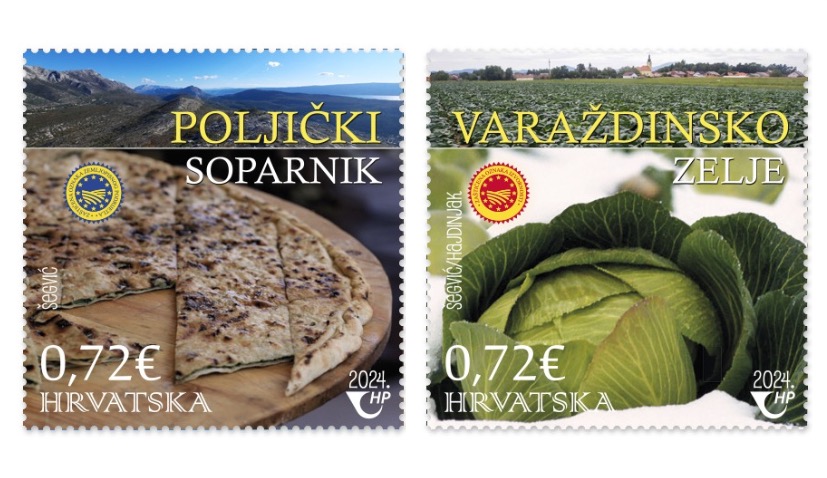
(Croatian Post)
Protected Croatian agricultural and food products on postage stamps New edition of commemorative stamps
ZAGREB, April 11, 2024 – Croatian Post will release on April 15, 2024, new commemorative postage stamps from the series “Croatian Protected Agricultural and Food Products”, featuring this year’s motifs: Poljički soparnik / Poljički zeljanik / Poljički uljenjak, Varaždin cabbage, and Zagorje turkey.
The author of the new commemorative postage stamps with a nominal value of 0.72 euros is the Split-based designer Duje Šegvić. Duje Šegvić also signed the photographs, except for Varaždin cabbage, which was captured for this occasion by photographer Željko Hajdinjak.
The stamps are issued in sheets of 9 stamps and in an edition of 25,000 copies per motif, accompanied by a first-day cover (FDC). The new commemorative stamps can be purchased at post offices or online at the website https://www.epostshop.hr/.
The accompanying leaflet text for the commemorative stamps was written by the Ministry of Agriculture.
Poljički soparnik / Poljički zeljanik / Poljički uljenjak
Poljički soparnik / Poljički zeljanik / Poljički uljenjak is thinly rolled dough in the shape of a pie filled with Swiss chard and red onions, baked on a hot open hearth grill sprinkled with ash. It is round, with a diameter of 90 to 110 centimeters.
The surface of the baked soparnik is brushed with olive oil and crushed or finely chopped garlic. Once baked and brushed, Poljički soparnik is cut into rhomboid-shaped pieces. It ranges in color from light yellow to light green, with sporadic scorched and cracked crusts, smelling of wood burned in an open fire and garlic.
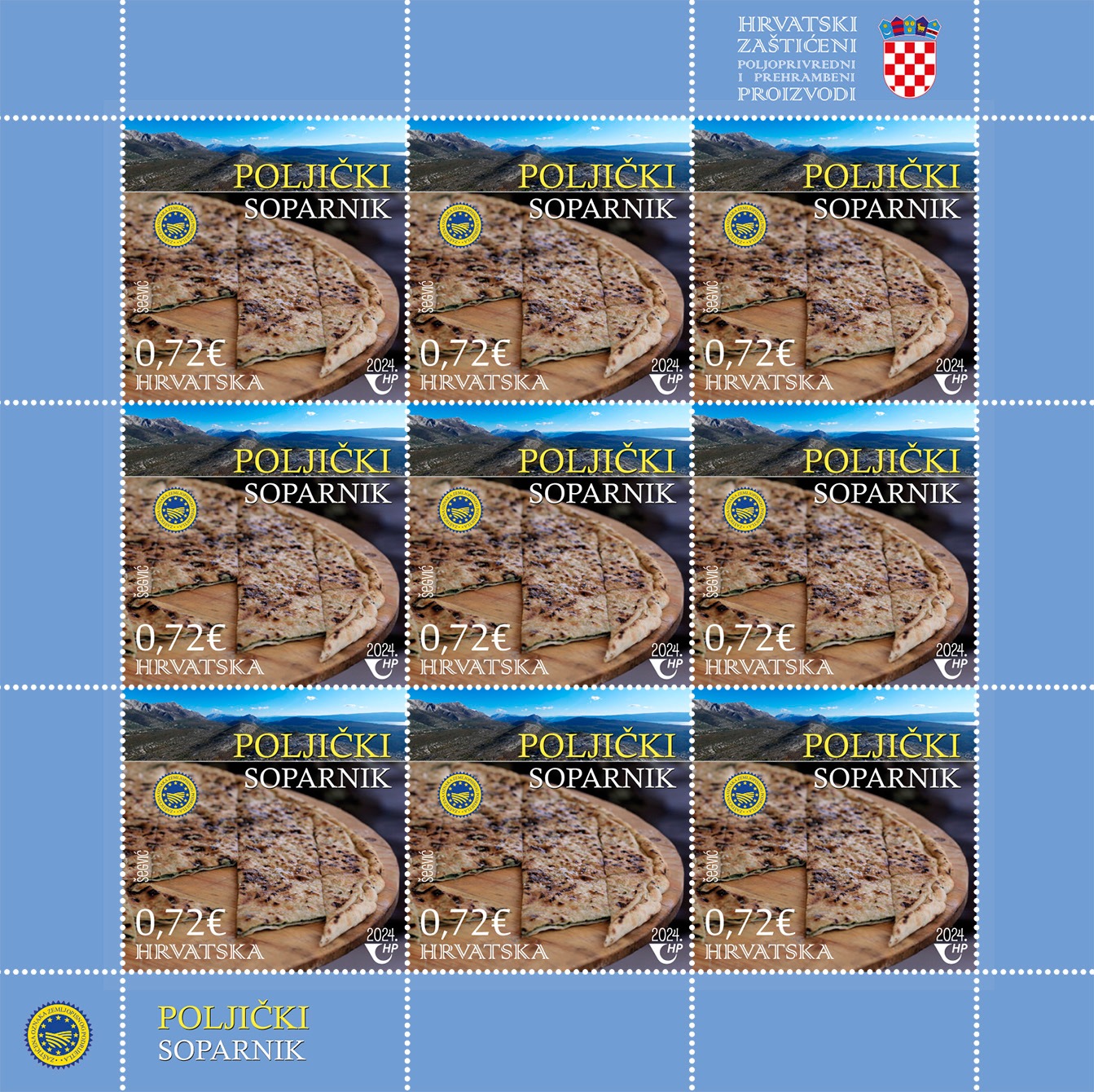
(Croatian Post)
The edge pieces are partially crispy, while those farther from the edge are soft and have a specific taste provided by the combination of Swiss chard, olive oil, and garlic. Poljički soparnik / Poljički zeljanik / Poljički uljenjak is a ceremonial, festive bakery product from the former Republic of Poljica, whose production dates back to the time of Turkish raids on the coast and the Dalmatian hinterland.
From stories passed down from generation to generation and available old records, it can be concluded that soparnik was a product for the poor. The scarce conditions of the rocky area of Poljica and the poverty of its inhabitants led Poljica women to produce this simple bakery product from the simple vegetable crops available to them (Swiss chard, red onions, and garlic), olive oil, and flour using their ingenuity and skill. The local art of preparing this product is particularly evident in the specific preparation of the dough edges, where women twist the lower and upper crusts of the dough with their hands and join them so that the filling remains between these crusts.
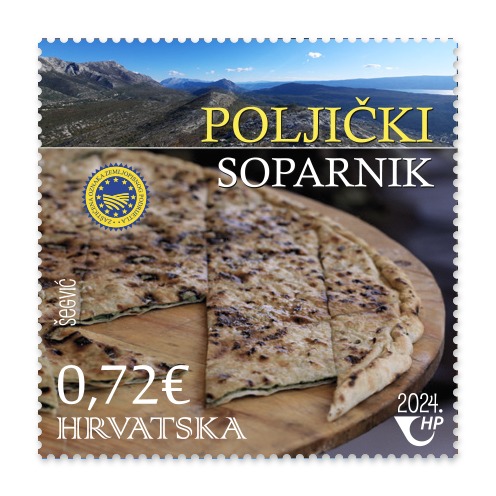
(Croatian Post)
Also, before baking, it is necessary to skillfully and very carefully place the soparnik on the hearth from wooden boards. Since it is very thin, too quick and clumsy handling can cause distortion or cracking of the product, thus losing its recognizable appearance. The geographical area of Poljica where Poljički soparnik / Poljički zeljanik / Poljički uljenjak is produced is bordered to the northeast by the Cetina River, to the west by the Žrnovnica River, and to the south by the Adriatic Sea. The settlement of Poljica consists of Donja (Lower), Srednja (Middle), and Gornja (Upper) Poljica.
Varaždinsko zelje/Varaždin cabbage
Varaždin cabbage is a vegetable culture obtained from the indigenous preserved variety of Varaždin cabbage. Varaždin cabbage heads are flat, dense in the upper part, and sometimes loose at the bottom. The outer leaves wrap the head well, and with the onset of technological maturity, the edge of the outer leaf usually begins to curl upward.
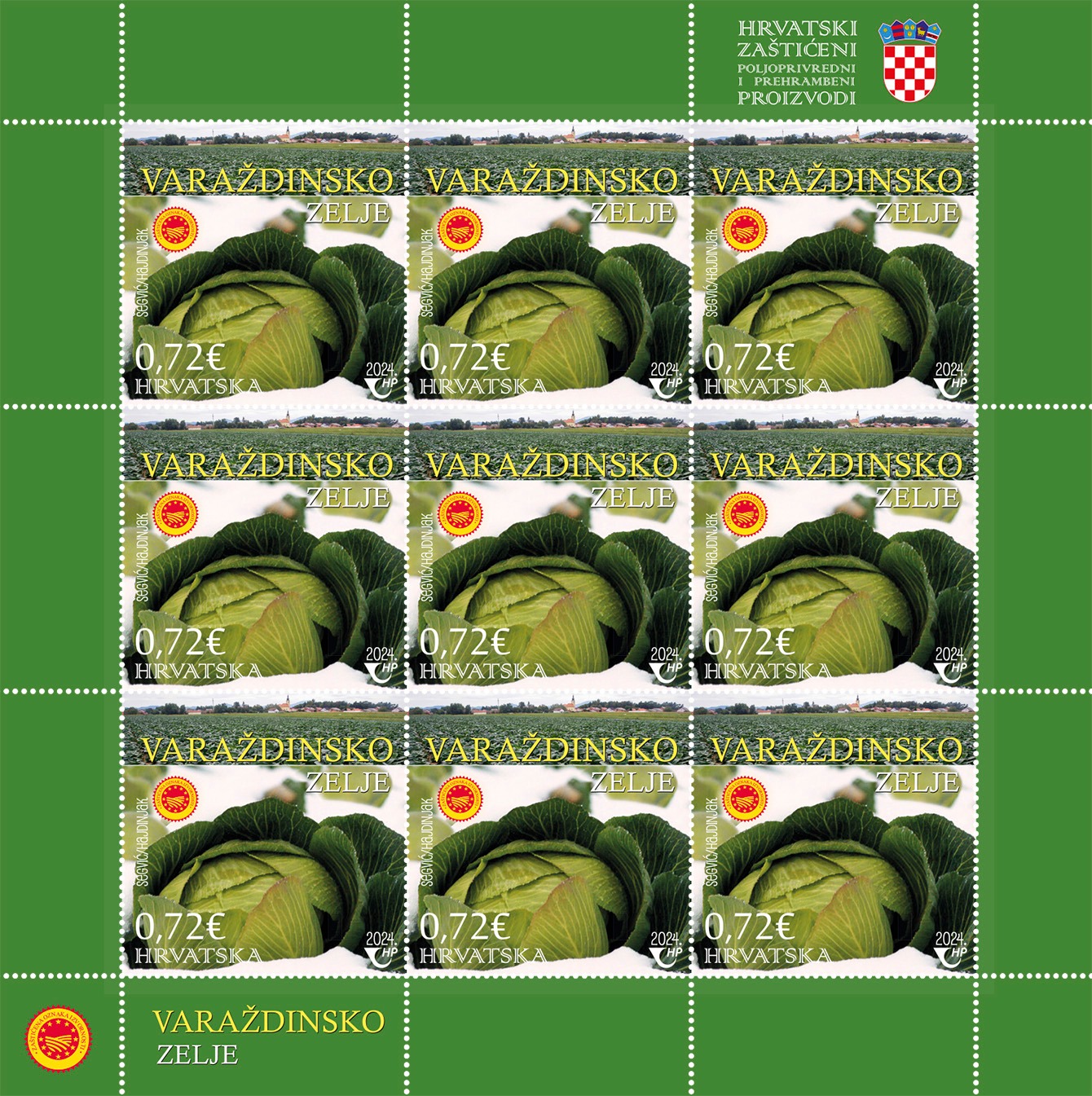
(Croatian Post)
The leaf plates are thin and have prominent leaf veins, with a color ranging from light olive-green. The leaf of Varaždin cabbage is so thin that the fingertips of the hand are visible when placed on the palm, while being elastic and firm. Varaždin cabbage has a bitter-spicy taste and a sharp scent of fresh cabbage. It belongs to the group of late cold-resistant varieties and can also be produced as early cabbage. It is characterized by a high content of dry matter and an extremely high sugar content.
Due to its elastic and thin leaves and bitter-spicy taste, Varaždin cabbage has become an indispensable ingredient in the preparation of Croatian traditional dishes. In the production of Varaždin cabbage, the skill of local producers is essential, especially in the harvesting phase, in which almost always family members, spanning multiple generations, participate, thus passing on experience and skill in manual harvesting. Personal assessment by the harvester, based on the experience and knowledge required to assess the maturity of the heads for harvesting, is important for manual harvesting.
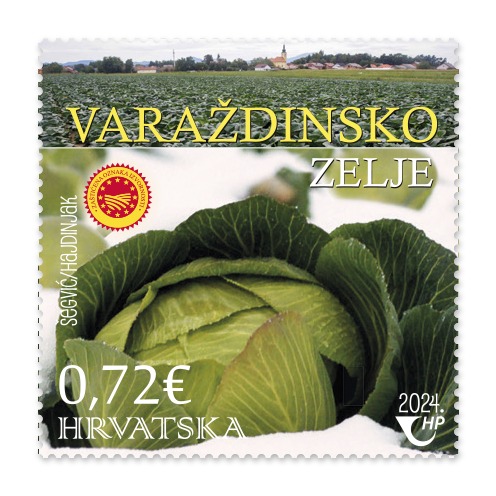
(Croatian Post)
By examining and feeling, the harvester assesses the heads and conducts selective manual harvesting, ensuring harvesting at the optimal degree of technological maturity. Manual harvesting also contributes to better preservation of cabbage heads and the absence of damage that occurs during mechanical harvesting. Through years of cultivation and acquired knowledge of growing Varaždin cabbage in specific conditions, producers have managed to obtain a product with special properties that cannot be achieved in other geographical areas due to the peculiarities of soil, climate, relief, and human influence.
One of the advantages of Varaždin cabbage is its suitability for outdoor production. Due to its resistance to low temperatures, Varaždin cabbage remains in the field until late autumn, eliminating the need for additional storage. The production of Varaždin cabbage is limited to the area within the administrative boundaries of Varaždin County.
Zagorski puran/Zagorje turkey
Zagorje turkey is fresh turkey meat from the indigenous Croatian breed of Zagorje turkey, obtained from turkeys and hens raised by free-range farming, which involves grazing in the open. Thanks to grazing and free movement in the open, the meat is extremely juicy and tender, with a moderate and pleasant scent. The Zagorje turkey breed has been raised in the Croatian Zagorje region since the second half of the 16th century. According to records from the Venetian Magistracy, it was brought to Croatian Zagorje from Italy, and according to them, the first roasted turkey was served on the table of the Lepoglava Paulines on the Feast of the Nativity of the Virgin Mary in 1561.
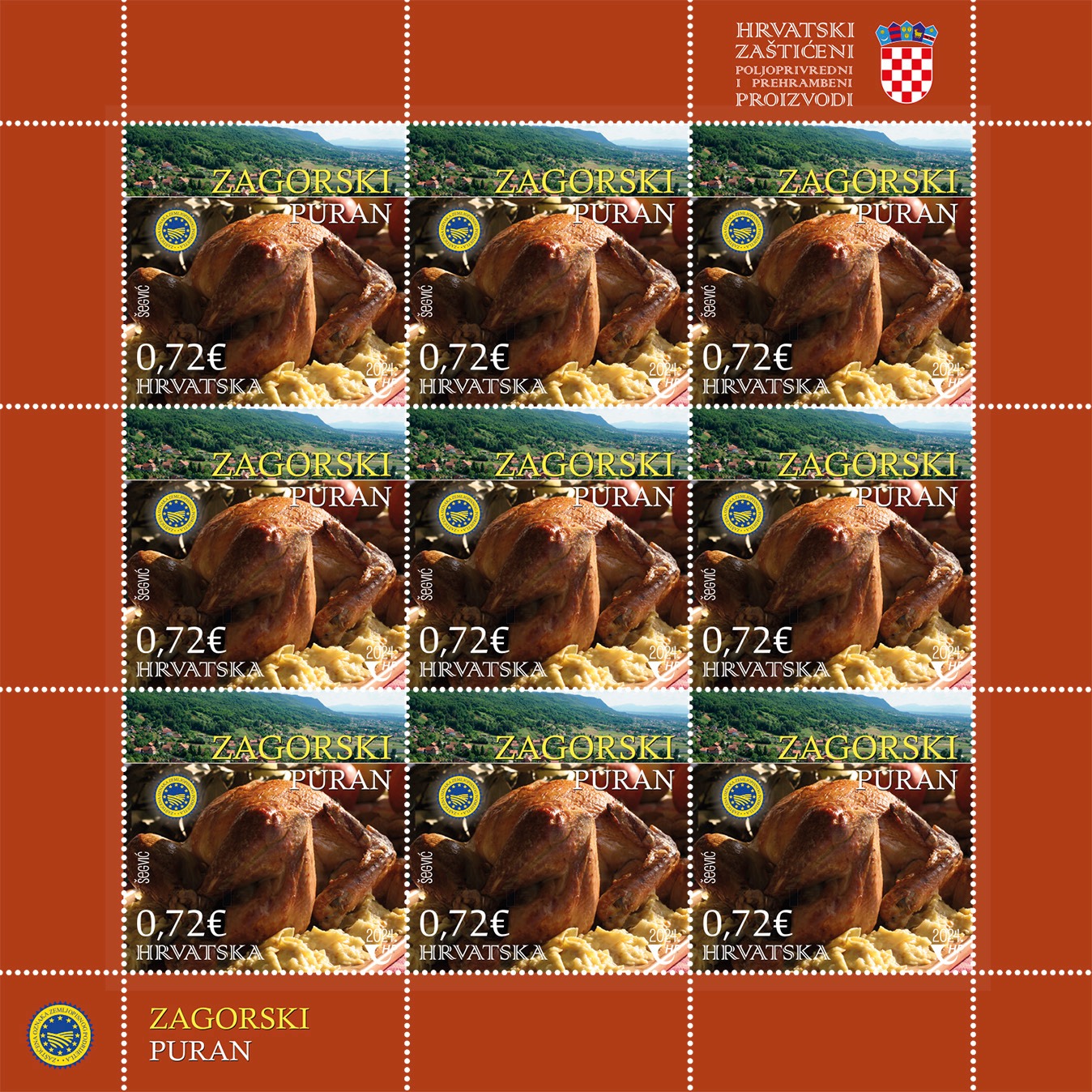
(Croatian Post)
Zagorje turkey is traditionally raised in a free-range farming system, where animals spend most of their lives outdoors, freely moving through meadows, orchards, woods, and other vegetation-rich habitats. Zagorje turkey meat has always been recognized as a specialty, meat of special quality, which is directly related to the traditional production technology of Zagorje turkey, which has developed and been preserved to this day in the Croatian Zagorje region.
Zagorje turkey meat is traditionally consumed on special occasions and is still the most common roast during holiday and family celebrations today. The name Zagorje turkey is closely related to the name of the breeding area of the same breed, Croatian Zagorje, where four types of Zagorje turkeys are bred for the production of Zagorje turkey: bronze, black, gray, and light.
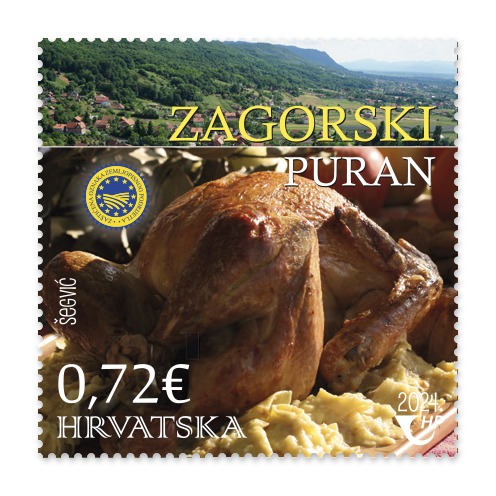
(Croatian Post)
The production of Zagorje turkey is maintained in the geographical area of Croatian Zagorje, which includes the entire area of Krapina-Zagorje County, the entire area of Varaždin County, and the peripheral parts of Zagreb County bordering Krapina-Zagorje and Varaždin County, namely the municipalities of Brdovec, Marija Gorica, Pušća, Dubravica, Luka, Jakovlje, Bistra, and Bedenica.

